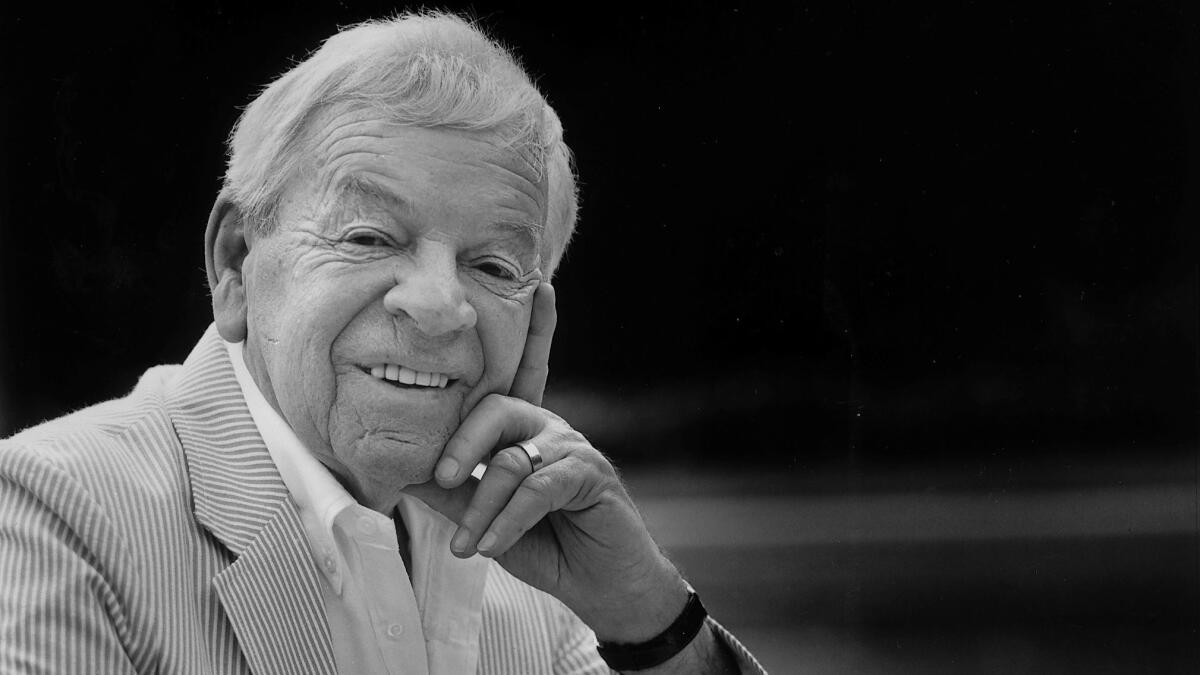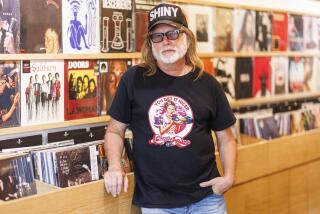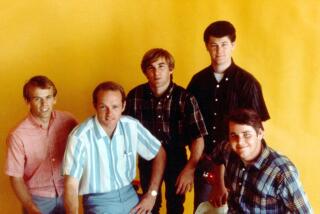From the Archives: Les Brown; With Band, He Defined an Era

Music would be a way out of the drudgery of his fatherâs bakery in a small Pennsylvania town, a young Les Brown once hoped. It became his ticket to the top of the entertainment world.
Brown, who died of lung cancer Thursday night in his Los Angeles home at the age of 88, and his Band of Renown made the hit parade in the 1940s with tunes like âJoltinâ Joe DiMaggio,â âSentimental Journeyâ and âIâve Got My Love to Keep Me Warm.â
The longtime bandleader for comedian Bob Hope, Brown was a fixture on radio, television and in concerts for nearly six decades.
As recently as five months ago, he was still touring with his group, playing about 60 concert dates a year. When Brown didnât lead the band, his son Les Jr. did.
âThe world has lost a great musician,â Hope said in a statement Friday. âI have lost my music man, my sideman, my straight man and a special friend. Dolores and I will miss him so much . . . so very much.â
Singer and actress Doris Day, who recorded âSentimental Journeyâ with Brown in 1945, said Friday that she âloved Les very much. I am going to miss his phone calls. The happiest times in my life were the days when I was traveling with Les and his band.â
Brownâs band played for television shows and golf tournaments, New Yearâs Eve galas, inauguration parties and business functions.
It played on the opening day at Disneyland in 1955 and performed there annually into the 1990s as part of the theme parkâs summer big band series.
It performed on Hopeâs radio and television shows and on âThe Steve Allen Showâ in the late 1950s and early 1960s. And, in its longest television run, it appeared on âThe Dean Martin Showâ from 1965 to 1974.
Never considered in the top rank of big band leaders with names like Tommy Dorsey, Glenn Miller and Benny Goodman, Brown nevertheless offered the public spirited renditions of the broad range of popular music from the American songbook.
âHe had a splendidly organized ensemble, one that never stepped too far across the border separating utilitarian dance tunes from orchestral music as an art form,â the late critic Leonard Feather wrote of Brown some years ago. âToday, he offers a package that is nice, precise, safe, conservative [and] inoffensive.â
Lester Raymond Brown was born in Reinerton, Pa. His father made his living as a baker but also played the soprano saxophone and was the town bandmaster. Brown and his three brothers learned music at home, Brown playing saxophone and later clarinet. He played his first gig, a local dance, at the age of 9.
âMusic to me was a way out of the bakery,â Brown told a reporter for the San Diego Union-Tribune some years ago. âMy dad had me working before school and after school. Iâd wrap the bread and clean the pans and turn the doughnuts.â
He received his formal musical training first at the Ithaca Conservatory of Music in upstate New York, then at Duke University, where he also led his first dance band, the Duke Blue Devils, on saxophone and clarinet.
Band Got Name From Announcerâs Ad-Lib
After the Blue Devils broke up in 1936, Brown moved to New York and found work as an arranger.
But an official of RCA-Victor Records saw promise in Brown and helped him gather a band to play at a local hotel. Named Les Brownâs Orchestra, its name changed in 1942 thanks to an ad-libbing radio announcer.
âWe were doing a remote broadcast, and one night an announcer said, out of the blue, âHereâs Les Brown and his band of renown,â â Brown told the Union-Tribune. âMy ears perked up. I liked the sound of it. And thatâs how itâs been ever since.â
His first big hit was âJoltinâ Joe DiMaggio,â a novelty tune celebrating an event that had kept American enthralled during the summer of 1941: Yankee slugger Joe DiMaggioâs 56-game hitting streak.
It also was during the 1940s that Brown signed a 17-year-old singer named Doris Day, and together they recorded a song that was to be the anthem for the military personnel coming home after World War II.
Written with Ben Homer and Bud Green, âSentimental Journeyâ spent 23 weeks in the top 10, with 17 weeks as No. 1.
âWe played the tune a few times before we recorded it,â Brown told Don Heckman, the Los Angeles Times jazz writer, a few years ago. âand people came up and said, âWhatâs that song?â . . . When the band finally recorded it, âit was a hit right out of the box. The only problem was that it was 1945, and there wasnât enough shellac to press all the copies that people wanted.â
The shellac shortage notwithstanding, âSentimental Journeyâ put the Brown band on the map and made Day a singing star.
âThe public loved her,â Brown later said. âWherever she went and whatever she sang, the public liked.â
In 1947, Brown replaced Desi Arnaz as Hopeâs musical director. A year later, the Brown band had another big hit with âIâve Got My Love to Keep Me Warm,â an instrumental version of the Irving Berlin song.
With Hope, the band started on radio and moved on to television. The Brown band provided accompaniment for 18 of Hopeâs Christmas tours overseas.
âEntertaining the troopsâthat was very rewarding,â Brown said in 1998. âWe got to see the world. For seven years, we went to Vietnam. Those guys needed the entertainment the most.â
And when they couldnât go, they sent the music with Hope.
When Hope toured in the Middle East in the 1980s, a U.S. Navy band sat in for the Brown ensemble, purely for visual effects on the camera.
Later, someone told Brown that the band sounded pretty good.
âThey shouldâve,â Brown replied. âIt was our music. They werenât blowing a note. If they had, they would have ruined the whole thing.â
One of the founding fathers of the National Academy of Recording Arts and Sciences, Brown served as the first president of the Los Angeles chapter and helped get the first Grammy Awards programs televised by convincing Hope, Bing Crosby and Frank Sinatra to participate.
Brown is also survived by his wife, Evelyn; daughter Denise Marsh; four grandchildren; two great-grandchildren; and a great-great-grandchild.
The family has asked that memorial donations be sent to the Michael Burke Foundation at the St. Johnâs Health Center in Santa Monica.
From the Archives: Renowed Jazz Bassist Charles Mingus Dies at 56
From the Archives: Ella Fitzgerald, Jazzâs First Lady of Song, Dies
Louie Bellson dies at 84; Duke Ellington called him âthe worldâs greatest drummerâ
From the Archives: Miles Davis, Jazz Legend and Innovator, Dies at 65
From the Archives: Frank Sinatra, Premier Vocalist of His Time, Dies at 82
More to Read
Start your day right
Sign up for Essential California for the L.A. Times biggest news, features and recommendations in your inbox six days a week.
You may occasionally receive promotional content from the Los Angeles Times.






